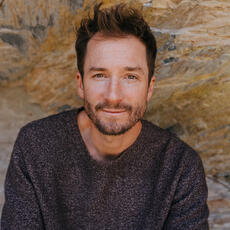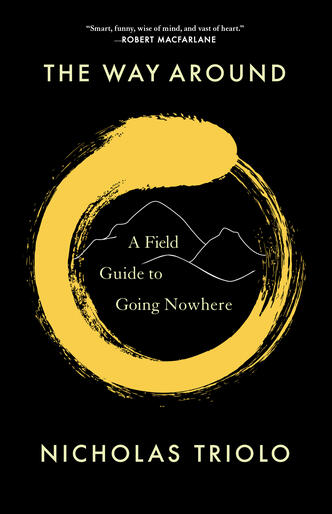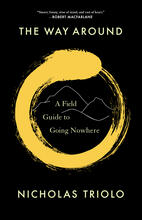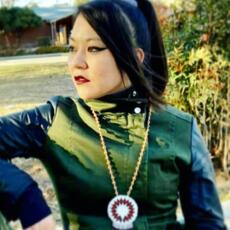Community Partner Spotlight: Nicholas Triolo Walks The Way Around with Owámniyomni Okhódayapi
Following a night of conversation with Robert Macfarlane to launch his latest novel, Is a River Alive?, Nicholas Triolo and Milkweed staff accompanied Owámniyomni Okhódayapi program director Barry Hand on a tour of St. Anthony Falls. There, they discussed Nicholas’ debut memoir, The Way Around: A Field Guide to Going Nowhere, restorative efforts on the historic riverfront in downtown Minneapolis, and what it means to strive toward mutual flourishing. The Way Around launches Tuesday, July 8th, with a reading hosted by Nicholas Triolo at the Missoula Public Library.
“How are you doing, Nick? You had such an amazing conversation with Rob last night,” our senior publicist, Morgan LaRocca, asks as we loop around downtown Minneapolis. “Has any of it come back to you yet?” In front, Nick laughs.“It felt like the opposite, actually! Maybe more of a hyper-presence?” Morgan nods, grinning. “Absolutely! They definitely fold in on each other.” Nicholas’ brow quirks, as if he can’t help himself. “Or circle back to one another,” he jokes, teasing a reference to his debut memoir, The Way Around: A Field Guide to Going Nowhere.
With Nicholas Triolo, it is all about following the shapes in life, whether in running or storytelling. “It felt great. Matching Rob’s level of eloquence was a tall order.” His eyes sweep across St. Anthony falls, a spark of recognition lights across his face. “I ran through here yesterday,” he admits, “a muskrat even cut right across my path—I nearly stepped on him!” On the opposite end of the trail, our Owámniyomni Okhódayapi tour guide, Program Director Barry Hand, emerges from the copse of trees, calling out to us.
“Come visit the cottonwoods! There’s two trees I’d like you to meet,” he says, grasping each of our hands. Before long, he is tugging us toward a semi-circle of cottonwoods, as if we are coming before a council of trees. Here, it is both a lesson on kinship and request. Suddenly, we aren’t a mix of publishers, environmentalists, and writers—as Barry explains—we’re simply a group of two-leggeds asking for permission to enter.
He leans down, cupping a handful of clover for us to consider. “We understand we’re related to this clover, for example, and treat it as wakȟáŋ—that which we don’t understand but intrinsically know to be sacred and holy. This cottonwood, too,” he says, gesturing to the branches looming over us. “Though the state of Minnesota considers it a nuisance, it’s one of our most sacred trees. Owámniyomni, too, is wakȟáŋ—I have to ask for permission. We’ll go on a walk in just a moment,” he promises, “we just have to get in one headspace in a society that seeks to both homogenize us even as it divides us. The Dakhóta choose to focus on similarities, not differences.”
“As a teacher of Dakhóta and Lakȟóta, I circle constantly between storytelling modes, speaking cyclically rather than linearly.” — Barry Hand, Program Director of Owámniyomni Okhódayapi
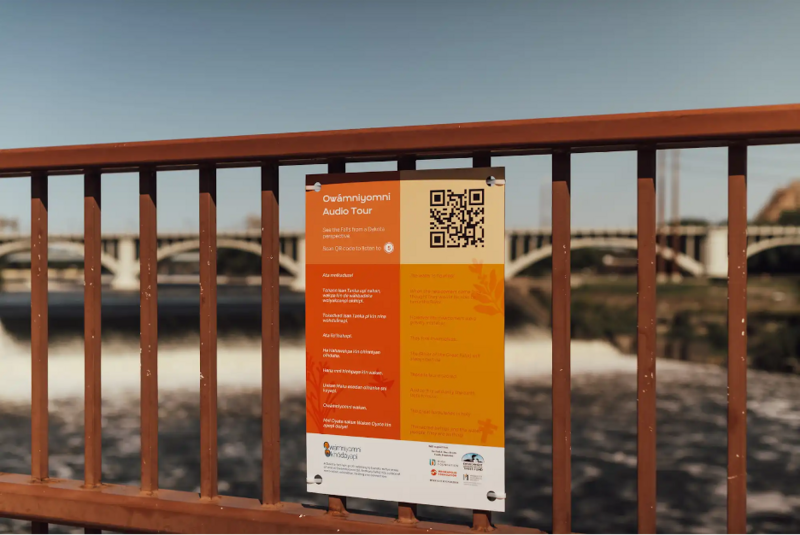
Photo Courtesy of Owámniyomni Okhódayapi.
With that, we set off on our walk, guided by one of several trail-markers: an orange sign headlined in equal parts Dakhóta and English. “If you scan this, you’ll hear Dakhóta spoken right here in our homeland, on sacred soil.” He says, though his smile wanes. “We reckoned with so many obstacles to get here: MNDOT, the Minnesota Historical Society, The City of Minneapolis, and the St. Anthony Heritage Foundation.” Here, Barry guides us to the right, where hi-vis construction tape snaps in the wind. “All this taped-off land you see is what we’re getting back from the Army Corps of Engineers. With time, we’ll restore it to the waterfront it used to be.” He traces his hand along the water’s edge, our eyes halting at the abrupt concrete slabs. “You’ll notice a section that’s permanently fenced. Though it’s the most sacred part of the falls, our people have trouble giving offerings. They’re forced to throw them. For us, what should be an act of reverent prayer ends in a kerplunk.”
“Here, the falls would collapse and repair itself annually, which we took to understand that the river was alive,” he says, falling into kinship with Robert Macfarlane and Nick Triolo’s conversation from just the night before. Beyond the fence, though, Barry points at the sluggish current. Whereas the surrounding water is alive and tumultuous, here it feels stagnant. “That’s where Spirit Island was, before it was blown up to accommodate barges and tugboats in the fifties. At some point, we hope to restore it. Eons of understanding were wiped away with one explosion and, though it’s been destroyed, we know Wakȟáŋ is still there.”
“Here, the falls would collapse and repair itself annually, which we took to understand that the river was alive.” — Barry Hand

Photo Courtesy of Owámniyomni Okhódayapi.
“It’ll take time to establish change but, when we do, we’re hopeful it’ll circle back to us so we can all benefit—because when one part of the cycle heals, we all do.” — Barry Hand
“As we partially restored the waterfront, the first thing we noticed were the muskrats, little water rodents that are vital to our creation stories. They weren’t just traditional food sources—they taught us traditional medicine. When we saw them, we asked, how can we take care of them? From the mussels to the muskrats, everything we implement bears them in mind. It’ll take time to establish change but, when we do, we’re hopeful it’ll circle back to us so we can all benefit—because when one part of the cycle heals, we all do.”
For Milkweed, part of repairing that cycle means elevating international authors through our Seedbank series, creating more opportunities for neurodivergent authors through our Multiverse series, and connecting writers with environmental stewards—like Nicholas Triolo and Owámniyomni Okhódayapi—to help nurture mutual flourishing in every part of the cycle, until we find the the way around, together.
The Way Around: A Field Guide to Going Nowhere launches Tuesday, July 8th, with a reading by Nicholas Triolo at the Missoula Public Library. To hear more about the mission and ongoing restoration project with Owámniyomni Okhódayapi, please listen to Barry Hand’s interview with Native Roots Radio.
